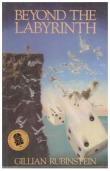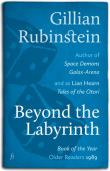AustLit
Latest Issues
AbstractHistoryArchive Description
'Life is difficult enough for Brenton. He can't get on with his parents, his younger brother is overtaking him in every way and now twelve-year-old Victoria must come and live with them too.
This turbulent, powerful novel follows Brenton as he loses himself in his beloved role playing games where the fantasy dangerously shadows real life'.
Source: author's website.
Notes
-
Also in lists selected for Horn Book Fanfare and 100 Best Children's Books NY (1991).
Publication Details of Only Known VersionEarliest 2 Known Versions of
Other Formats
- Also braille and sound recording.
Works about this Work
-
Children of the Apocalypse
2011
single work
criticism
— Appears in: Apocalypse in Australian Fiction and Film : A Critical Study 2011; (p. 108-134)This chapter explores apocalypse in children's literature with reference to literary attitudes to children, nature and dystopia. Examinations of works by Lee Harding, Victor Kelleher, and John Marsden then focus on how these writers adapt apocalyptic themes for a juvenile audience. Their novels display tyranny, large-scale catastrophe, invasion, and children in danger, and their apocalyptic settings reveal anxieties about isolation, invasion, Indigenous land rights and colonization. (108)
-
y
 Voracious Children : Who Eats Whom in Children's Literature
London
New York (City)
:
Routledge
,
2006
16055228
2006
multi chapter work
criticism
Voracious Children : Who Eats Whom in Children's Literature
London
New York (City)
:
Routledge
,
2006
16055228
2006
multi chapter work
criticism
'Voracious Children explores food and the way it is used to seduce, to pleasure, and coerce not only the characters within children's literature but also its readers. There are a number of gripping questions concerning the quantity and quality of the food featured in children's fiction that immediately arise: why are feasting fantasies so prevalent, especially in the British classics? What exactly is their appeal to historical and contemporary readers? What do literary food events do to readers? Is food the sex of children's literature? The subject of children eating is compelling but, why is it that stories about children being eaten are not only horrifying but also so incredibly alluring? This book reveals that food in fiction does far, far more that just create verisimilitude or merely address greedy readers' desires. The author argues that the food trope in children's literature actually teaches children how to be human through the imperative to eat "good" food in a "proper" controlled manner. Examining timely topics such as childhood obesity and anorexia, the author demonstrates how children's literature routinely attempts to regulate childhood eating practices and only award subjectivity and agency to those characters who demonstrate "normal" appetites.
'Examining a wide range of children's literature classics from Little Red Riding Hood to The Lion, the Witch and the Wardrobe, this book is an outstanding and unique enquiry into the function of food in children's literature, and it will make a significant contribution to the fields of both children's literature and the growing interdisciplinary domain of food, culture and society.'
Source: Publisher's blurb.
-
Untitled
2001
single work
review
— Appears in: Fiction Focus : New Titles for Teenagers , vol. 15 no. 3 2001; (p. 52)
— Review of Beyond the Labyrinth 1988 single work novel -
All Our Christmases Come at Once: War, Peace and the 'Fin de Siecle'
2000
single work
criticism
— Appears in: Papers : Explorations into Children's Literature , December vol. 10 no. 3 2000; (p. 32-37) Scutter examines a range of children's texts which are predominantly British, although a few American and Australian works are represented, including Gillian Rubinstein's Beyond the Labyrinth and Sonya Hartnett's Sleeping Dogs. Fascinated with representations of Christmas in children's fiction, Scutter argues that 'In many children's books...the mythos of Christmas forms a motif which sets a particular kind of family, child, nation and culture against the mythos of war' (32). Focusing on the fin de siecle, as characterised by 'tranformative millenialism, enervation and impotence' (32), she says 'The anxious enervation of our culture is marked not only by early rehearsal of ends of cycles, and of cultural rituals such as Christmas and Easter, but also the end of childhood to adolescent and young adulthood' (32). While there has been a shift in representations of Christmas, war and peace, Scutter concludes that the fin de siecle of children's texts continues to rely on a sense of apocolypse in what she views as as ongoing and 'anxious attempts to recuperate threatened cultural values' (36). -
Metafictional Play in Children's Fiction
1998
single work
criticism
— Appears in: Papers : Explorations into Children's Literature , December vol. 8 no. 3 1998; (p. 5-15)Grieve examines the role of metafiction in children's literature and its reliance on reader participation and interaction, by looking at textual strategies that construct the 'game' as text or fiction. These strategies include structuring the narrative around the rules of an actual game, constructing either the physical book or the text as a game, and/or representing characters as 'players in a game' (5). The discussion is a response to critics who question the value of child-focused metafictional texts and of narrative techniques that demystify fictional illusions (such as multiple narrative endings, unreliable narrators and characters, linguistic play, and the reworking of established literary codes and conventions through parody and intertextuality).
Grieve explores a number of texts based on the 'interrogative or metafictional play' and self-reflexivity the narratives offer, which, she argues, 'makes the reader aware of the interplay between reality and illusion' (6). As well as novels from the UK and the USA, Grieves discusses a number of Australian texts: Power and Glory (Emily Rodda and Geoff Kelly), Beyond the Labyrinth (Gillian Rubinstein), Inventing Anthony West (Gary Crew), and The Water Tower (Gary Crew and Steven Woolman).
Metafiction challenges the dominant humanist literary tradition, which posits 'stable, knowable texts' (5), by 'problematizing mimetic illusion' and questioning the 'nature and existence of reality, the creation of literary universes and the nature of human artefacts' (13). This is the value of metafictive narratives for children that Grieve elucidates and ultimately supports.
-
Untitled
1989
single work
review
— Appears in: Magpies : Talking About Books for Children , March vol. 4 no. 1 1989; (p. 31)
— Review of Beyond the Labyrinth 1988 single work novel -
Untitled
2001
single work
review
— Appears in: Fiction Focus : New Titles for Teenagers , vol. 15 no. 3 2001; (p. 52)
— Review of Beyond the Labyrinth 1988 single work novel -
Kids' Books for Christmas
1988
single work
review
— Appears in: Australian Book Review , December no. 107 1988; (p. 26-28)
— Review of Drac and the Gremlin 1988 single work picture book ; Regina's Impossible Dream 1988 single work children's fiction ; Bill 1988 single work children's fiction ; The Best-Kept Secret 1988 single work children's fiction ; Answers to Brut 1988 single work children's fiction ; The Inheritors 1988 single work novel ; Baily's Bones 1988 single work novel ; Beyond the Labyrinth 1988 single work novel -
Warning : These Books Stretch the Mind
1989
single work
review
— Appears in: The Australian Magazine , 25-26 March 1989; (p. 8)
— Review of The Journey 1988 single work novel ; Beyond the Labyrinth 1988 single work novel -
Australian Children's Book of the Year Awards 1989 short list.
1989
single work
review
— Appears in: Scan , May vol. 8 no. 4 1989;
— Review of Beyond the Labyrinth 1988 single work novel -
Know the Author : Gillian Rubinstein
Alfred R. Mappin
(interviewer),
1989
single work
interview
— Appears in: Magpies : Talking About Books for Children , July vol. 4 no. 3 1989; (p. 18-20) -
A Hero is a Man...???
1993
single work
column
— Appears in: Magpies : Talking About Books for Children , May vol. 8 no. 2 1993; (p. 5-9) -
The Stare's Empty Nest : Some Views on Four Writers
1993
single work
column
— Appears in: Magpies : Talking About Books for Children , September vol. 8 no. 4 1993; (p. 20-22) -
Gillian Rubinstein's Beyond the Labyrinth : A Court Case and its Aftermath
1996
single work
criticism
— Appears in: Para-doxa , vol. 2 no. 3-4 1996; (p. 332-345) -
Living with Ourselves : Recent Australian Science Fiction for Children and Young People
1990
single work
criticism
— Appears in: Children's Literature Association Quarterly , vol. 15 no. 4 1990; (p. 185-189) Nimon observes that Australian science fiction for children tends to present futuristic narratives that are 'earthbound' rather than 'launching into the void between the stars or touching down on remote and wonderous planets' (185). She claims that writers of juvenile science fiction 'find Australia itself to be a challenging terrain...a continent whose people are neither comfortable nor assured in their possession of it' (185). Following a discussion of novels by Lee Harding (Displaced Persons, Waiting for the End of the World), Victor Kelleher (Taronga, The Makers), and Gillian Rubinstein (Beyond the Labyrinth, Skymaze and Space Demons), Nimon claims that as well as the tendency of Australian science fiction for children to remain earthbound, there is a pervasive theme of individualization, 'where the dangers encountered and the foes met are the powers of our own desires and weaknesses; we battle to control our unruly selves' and as such, 'the future lies in our own hands' (188).
Awards
- 1990 winner Festival Awards for Literature (SA) — Children's Literature Award
- 1989 winner CBCA Book of the Year Awards — Book of the Year: Older Readers
- 1989 shortlisted Ditmar Awards — Best Australian Long Fiction
- 1989 shortlisted Victorian Premier's Literary Awards — Alan Marshall Award for Children's Literature
- South Australia,







